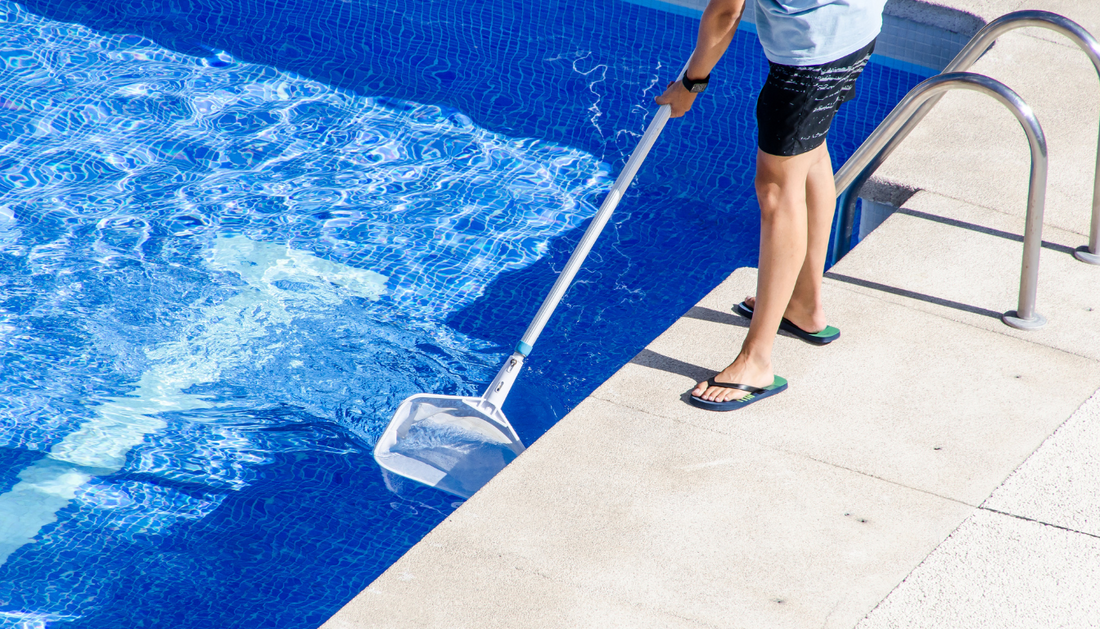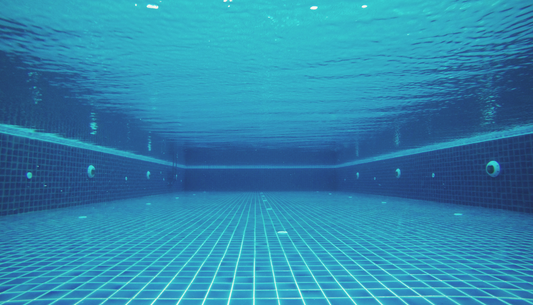
Pool Care 101: How to Maintain a Pool for Beginners
Proper pool care means sticking to a routine. This includes understanding your pool's systems, like the pump and filter. It also means knowing about water chemistry and how to clean your pool regularly. Learning these basics makes maintenance easier and helps you fix problems fast.

Understanding Your Pool's Components
Learning about your pool's parts is key to keeping it clean. The pool pump is at the heart of this, making sure water moves well. This is vital for clear and clean water.
The pump pushes water through filters, removing dirt and bad stuff. There are different filters, each with its own job:
- Sand Filters: Catch particles in a sand bed, needing backwashing to clean.
- Cartridge Filters: Use a cartridge to filter out bad stuff, needing less upkeep.
- Diatomaceous Earth (D.E.) Filters: Use powder to catch tiny particles, giving top-notch filtration.

Skimmers and returns are like veins and arteries for your pool. Skimmers pull water from the surface, catching debris. Then, returns send clean water back, keeping the pool moving and water quality up.
Running the pump for 10 to 12 hours daily is a must. It stops algae and bacteria from growing and keeps water moving. It also helps spread chemicals like chlorine, keeping the water safe.
Knowing how these parts work together is essential for a clean pool. A good pump, filters, and circulation make your pool a great place to swim.
The Three C's of Pool Maintenance: Circulation, Cleaning, and Chemistry
Effective pool maintenance is all about the three C's: Circulation, Cleaning, and Chemistry. Knowing and applying these will keep your pool healthy and clear. This makes it fun for everyone.
Circulation is key. A good pump and filter system are vital for water flow. Aim to turn the water over twice a day. This means filtering 20,000 gallons in a 10,000-gallon pool.
Using variable speed pumps can save energy while filtering better. This is because they run longer at slower speeds.

For good circulation, run the filter for 10 to 12 hours daily. This turns the water over several times. Backwashing the filter often removes contaminants. This prevents cloudy water, algae, and other problems.
Cleaning is also crucial. Clean the pool weekly at least. Use automatic cleaners to save time. Tools like baking soda paste and tennis balls can help too.
For better cleaning, use pantyhose on skimmer baskets. This creates a finer filter. These tips make pool maintenance easier.
Chemistry is the third important part. Regular chemical tests keep the pool balanced. This avoids foaming, cloudy water, and algae.
Pool Stop recommends adding chemicals often. This prevents red eyes, skin issues, and scale buildup. Keep pH levels between 7.4 to 7.6 and alkalinity between 100 to 150 ppm.
Adjusting these levels right avoids acidity or basicity spikes. Keep sanitizer levels correct for safety and clarity.
Following these three C's—Circulation, Cleaning, and Chemistry—keeps your pool clean and inviting all season.
How to Maintain a Pool for Beginners?
Keeping a pool clean for beginners can seem tough. But, with a clear plan, you can keep your pool sparkling and safe. A key part is making sure the chemical balance is right and testing the water often.
Begin by testing the water regularly. Check the pH, chlorine, and other chemicals. Aim for pH levels between 7.4 and 7.6. Chlorine should be between 1.0 and 3.0 ppm. Test the water monthly at a pool store for a detailed check.
Skim the pool's surface often to remove leaves and debris. Brush the walls weekly to stop algae and sediment. Vacuum after brushing to get rid of any leftover particles. Clean the skimmer basket, filter, and pump often. Pool filters need a deep clean yearly, and cartridge filters should be cleaned three times a year.
| Task | Frequency |
|---|---|
| Water Testing for Chemical Balance | Twice a Week |
| Brushing Pool Walls | Weekly |
| Vacuuming | Weekly |
| Cleaning Skimmer Basket | Weekly |
| Deep Clean Pool Filters | Annually |
Regular checks and repairs are key for a pool. Look for cracks in the pump and filter system often. Lubricate O-rings to avoid problems. Run the pump 10 hours a day when in use and a few hours daily when not. Shock the pool weekly with chlorine, especially at dusk or night, for deep cleaning.
Regular care can make your pool's parts last longer. Vinyl liners can last 10-15 years with proper care. Hiring pros like Poolwerx at $60 to $100 an hour can help a lot and ensure your pool is well cared for.
Effective Circulation Techniques
Keeping your pool water clean and healthy is key. Understanding your pump and filter systems is crucial. Running the pump for at least 8 hours a day helps spread chemicals and clear debris.
To pick the right pump, divide your pool's size by 480. This ensures it works well for 8 hours. Filters need weekly cleaning to avoid clogs. Cartridge filters might need to be replaced every three weeks, especially when the pool is busy.
Backwashing your filter system is a smart move. It gets rid of debris that blocks water flow. Also, clean areas like behind steps or under the skimmer to keep dirt away.
Keep water levels at two-thirds of the skimmer height to protect the pump. Pointing return jets down at a 45-degree angle helps mix and circulate water.
| Technique | Action | Benefit |
|---|---|---|
| Running the Pump | 8 hours/day | Distributes chemicals, removes debris |
| Cleaning Filters | Weekly | Prevents clogging, ensures flow |
| Backwashing | Regularly | Removes debris, optimizes flow |
| Adjusting Jets | 45-degree angle | Promotes water mixing |
| Maintaining Water Levels | Two-thirds skimmer height | Prevents pump damage |
Take out toys and accessories when not in use to avoid clogs. A pool cover can also help by keeping debris out and reducing filter work.
By using these circulation tips, your pool water will stay clean and healthy. Good water flow is essential for pool care, making your swimming area perfect.
Easy Pool Cleaning Tips
Keeping your pool clean is key for looks and health. A Weekly Skimming Routine helps get rid of floating stuff like leaves and bugs. This stops them from sinking and rotting, which harms the water.
- Weekly Skimming Routine: Use a pool skimmer net to gently sweep the surface. This catches any floating debris.
- Brushing and Scrubbing: Brushing the walls and floor is vital. It stops algae and removes dirt. Pay extra attention to areas like steps and corners.
- Using a Pool Vacuum: A pool vacuum picks up dirt and debris from the floor. Vacuuming weekly keeps your pool clean.
| Pool Type | Dimensions | Water Volume (gallons) |
|---|---|---|
| Rectangular Above Ground | 12ft x 24ft, 4ft depth | 8,640 |
| Inground Pool | 16ft x 32ft, 3ft to 8ft depth | 21,120 |
| Round Pool | 24ft diameter, 4ft depth | 13,564.8 |
Finally, sticking to a Weekly Skimming Routine and brushing and vacuuming keeps your pool inviting. These easy pool cleaning tips help keep your pool clean all season.
Choosing the Right Pool Chemicals and Products
Choosing the right pool chemicals is key to keeping your pool clean and safe. It's important to know what each chemical does. This way, you can keep your pool water clear and free from harmful stuff.
Chlorine is a top choice for keeping pools clean. It kills bacteria and stops algae from growing. You can pick from liquid chlorine or trichlor tablets, which last longer.
Bromine is another good option. It's gentler on skin and doesn't smell as bad as chlorine.
It's crucial to keep your pool's pH level between 7.4 and 7.6. You can use pH increasers and reducers to do this. Also, alkalinity adjusters help keep the water stable.
Test your pool water often, at least twice a week. Use test strips or kits to check pH, alkalinity, and chlorine levels. This keeps everything in balance.
Pool shock treatments are great for getting rid of bad stuff. Shocking your pool weekly helps prevent algae and bad smells. Saltwater pools need high-purity pool salt to avoid stains and make chlorine better.
Special products like algaecides and metal stain removers can help with algae and stains. Choosing the right products makes pool care easy and effective for anyone.
FAQ
What are the basic steps to maintain a pool for beginners?
For beginners, pool maintenance is simple. First, learn about your pool's parts. Then, create a cleaning schedule. Make sure the water chemistry is right and the water flows well.
Check and clean the pump, skimmers, and filters often. Test the water for the right chemical levels. Also, remove debris by skimming and vacuuming.
Why is understanding my pool's components important?
Knowing your pool's parts is key. It helps keep the water clear and clean. The pump moves water through the filter, removing dirt.
Skimmers and returns help water flow evenly. This keeps the pool water fresh and healthy.
What do the three C's of pool maintenance stand for?
The three C's are Circulation, Cleaning, and Chemistry. Circulation means running the pump and keeping water moving. Cleaning removes debris and stops algae.
Chemistry is about testing and balancing the water. This keeps the pH and sanitizer levels safe for swimmers.
How do I maintain chemical balance and test pool water?
To keep the water balanced, test it regularly. Use test kits to check pH, chlorine, alkalinity, and calcium hardness. Adjust chemicals as needed.
Chlorine tablets help keep the water clean and safe. They are a common choice for pool hygiene.
What are effective circulation techniques for a pool?
Good circulation means running the pump enough each day. Backwash the filter now and then. Adjust the jets for better water flow.
This prevents algae and cloudy water. It ensures chemicals spread evenly throughout the pool.
What does a weekly skimming routine involve?
Weekly skimming removes floating debris like leaves and bugs. Use a skimmer net for this. It keeps the pool surface clean and makes maintenance easier.
How do I choose the right pool chemicals and products?
Choosing the right chemicals is important. Learn about chlorine tablets, pH balancers, and shock treatments. Follow the manufacturer's advice for a safe pool.
Good chemical management keeps swimmers safe and the pool in good shape for longer.

